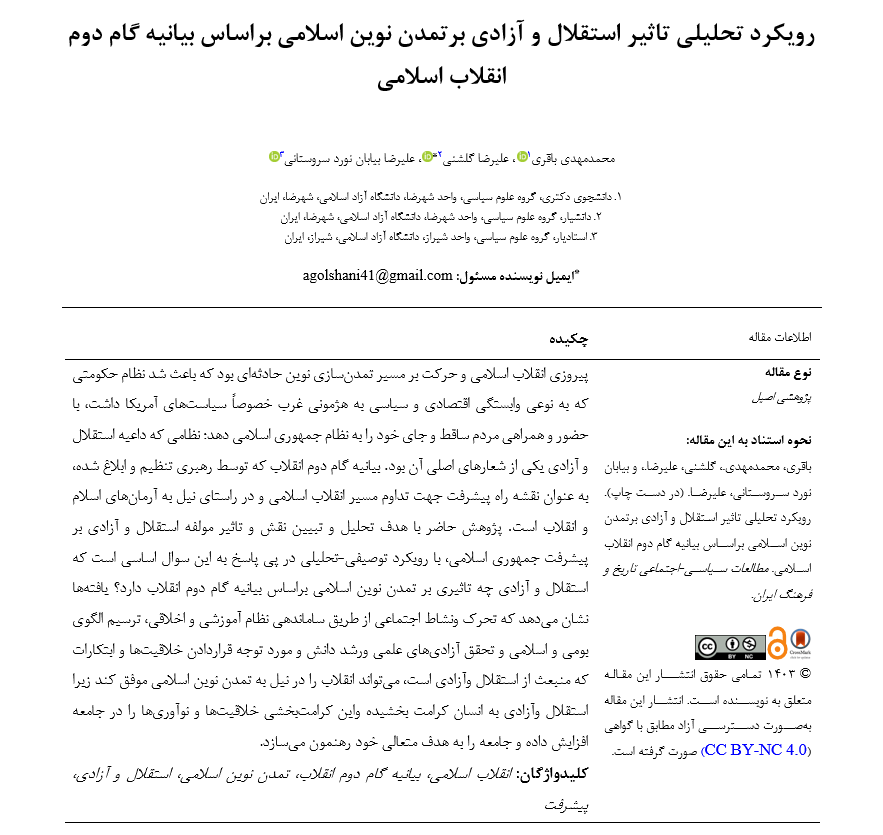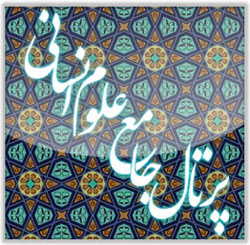The Analytical Approach to the Impact of Independence and Freedom on the New Islamic Civilization Based on the Statement on the Second Step of the Islamic Revolution
Keywords:
Islamic revolution, statement of the second step of the revolution, new Islamic civilization, independence and freedomAbstract
The victory of the Islamic Revolution and its movement toward the construction of a new civilization was an event that led to the collapse of a governmental system that had economic and political dependence on Western hegemony, particularly the policies of the United States, and its replacement with the Islamic Republic, a system that upheld independence and freedom as one of its core slogans. The Statement on the Second Step of the Revolution, formulated and issued by the Supreme Leader, serves as a roadmap for progress to sustain the trajectory of the Islamic Revolution and achieve the ideals of Islam and the Revolution. This study aims to analyze and elucidate the role and impact of the components of independence and freedom on the progress of the Islamic Republic. Employing a descriptive-analytical approach, it seeks to answer the fundamental question: What effect do independence and freedom have on the new Islamic civilization based on the Statement on the Second Step of the Revolution? The findings indicate that social dynamism and vitality can be fostered through the organization of the educational and ethical system, the delineation of a native and Islamic model, the realization of academic freedoms, the growth of knowledge, and the emphasis on creativity and innovation, all of which stem from independence and freedom. These elements can contribute to the Revolution’s success in achieving the new Islamic civilization. This is because independence and freedom bestow dignity upon individuals, and this sense of dignity enhances creativity and innovation within society, ultimately guiding the community toward its supreme objective.
Downloads
References
Aqili, B. (1993). Teymourtash in the Scene of Politics. Javidan.
Dehshiri, M. R. (2015). New Islamic Civilization: Foundations and Prospects. Proceedings of the National Conference on New Islamic Civilization, Tehran.
Durant, W. (1991). The Story of Civilization (The Dawn of Civilization). Organization for the Publication of Educational Materials.
Foucault, M. (2007). What Do Iranians Dream About? Hermes.
Ibn Duraid, M. b. H. (1988). Jamharah al-Lughah. Dar al-Ilm lil-Malayin.
Jafari, M. T. (1981). Hayat-e Ma’qul. Sima-ye Nur.
Jan Ahmadi, F. (2007). History of Islamic Culture and Civilization. Ma’aref.
Khajeh Servi, G., & Fathi, M. J. (2014). The Main Components of Civilization-Building in the Islamic Revolution (with Emphasis on the Role of Rationality, Spirituality, and Science). Journal of Islamic Revolution Research, 11.
Khorramshad, M. B. (2011). Reflections of the Islamic Revolution of Iran. Samt.
Motahhari, M. (1998). On the Islamic Revolution. Sadra.
Motahhari, M. (2006). Collection of Works. Sadra Publications.
Najafi, M. (2011). Superior Civilization. Arma.
Nasri, M. (2008). Iran: Yesterday, Today, and Tomorrow. Nashr-e Ma’aref.
Pahlavi, M. R. (1988). Answer to History. Mahris.
Robbins, A. (2004). Unlimited Power. Raha-ye Bain.
Tabatabai, S. M. H. (1417). Al-Mizan fi Tafsir al-Quran. Office of Islamic Publications.
Taherzadeh, A. (2012). Shia Civilization. Lab-e Mizan.
Ya’qubi, A. a.-R. (2008). Interaction between Islamic and Western Civilizations. Ma’aref Quarterly, 45.
Zaidan, J. (2010). History of Islamic Civilization. Amir Kabir.

Downloads
Published
Submitted
Revised
Accepted
Issue
Section
License
Copyright (c) 2025 Mohammad Mehdi Bagheri (Author); Alireza Golshani; Alireza BiyabanNavard Sarvestani (Author)

This work is licensed under a Creative Commons Attribution-NonCommercial 4.0 International License.







